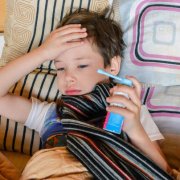In a previous blog we already talked about Volatile Organic Compounds. Volatile organic compounds are organic chemicals that become a gas at room temperature. There are thousands of VOCs and a multiple of VOC’s are at the same time present. What are TVOCs?
What are Volatile Organic Compounds?
As said, these are organic chemicals that become a gas at low temperature levels. Or more practically put: they become gas at room temperature.
Or more scientific:
Volatile organic compounds, or VOCs are organic chemical compounds whose composition makes it possible for them to evaporate under normal indoor atmospheric conditions of temperature and pressure
They have a low boiling point, which results in high vapor pressure. This causes many molecules to evaporate or sublimate from the liquid or solid form of the compound to enter the surrounding air. This is called volatility: the ease of a substance to vaporize at a given temperature.
The EPA remarks: “Normal indoor atmospheric conditions of temperature and pressure used here refers to the range of conditions usually found in buildings occupied by people. Thus, depending on the type of building and its geographic location, the temperatures could be from the mid-30s (in Fahrenheit degrees) to the 90° F range and the pressure could be from sea level to the elevation of mountains where buildings might be located. This is not to be confused with “Standard Temperature and Pressure,” often used in analysis and presentation of scientific studies, but defined variously by different authorities. The most used, although not universally adopted, definitions are those of the International Union of Pure and Applied Chemistry (IUPAC) and the National Institute of Standards and Technology (NIST). IUPAC’s standard is a temperature of 0° C (273, 15 K, 32° F) and an absolute pressure of 100 kPa (14.504 psi), NIST’s definition is a temperature of 20° C (293, 15 K, 68° F) and an absolute pressure of 101.325 kPa (14.696 psi).”
Some examples of VOC’s are:
- Benzene
- Ethylene glycol
- Formaldehyde
- Methylene chloride
- Tetrachloroethylene
- Toluene
But in fact, there are thousands of VOC’s. And they are everywhere. They occur naturally or may be human-made.
They can be generated from many products, such as paints, glues, fossil fluids. Some everyday examples you might not even realize: terpenes released when you peel an orange. Or the squalene from human skin oil. When they react with ozone, they form even more toxic molecules.
Some VOCs are immediately dangerous to the environment or humans, but mostly are not. Other VOCs are non-hazardous. If a VOC has impact on your health depends on indoor concentration, time spent indoors and hazardousness of the VOC.
If VOCs are harmful, these are mostly long-term health effects. However, there is still much research to be done. And as stated in the previous article, they may not be harmful for your health, but may lessen your sense of well-being and productivity.








Leave a Reply
Want to join the discussion?Feel free to contribute!